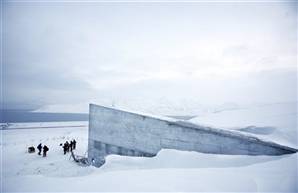Frozen ‘Garden of Eden’ secures biological diversity for future generations
LONGYEARBYEN, Norway – A “doomsday” seed vault built to protect millions of food crops from climate change, wars and natural disasters opened Tuesday deep within an Arctic mountain in the remote Norwegian archipelago of Svalbard.

“The Svalbard Global Seed Vault is our insurance policy,” Norway’s Prime Minister Jens Stoltenberg told delegates at the opening ceremony. “It is the Noah’s Ark for securing biological diversity for future generations.”
European Commission President Jose Manuel Barroso and 2004 Nobel Peace Prize winner Wangari Maathai of Kenya were among the dozens of guests who had bundled up for the ceremony inside the vault, about 425 feet (130 meters) deep inside a frozen mountain.
“This is a frozen Garden of Eden,” Barroso said, standing in one of the frosty vaults against of backdrop of large discs made of ice.
The vault will serve as a backup for hundreds of other seed banks worldwide. It has the capacity to store 4.5 million seed samples from around the world and shield them from man-made and natural disasters.
Dug into the permafrost of the mountain, it has been built to withstand an earthquake or a nuclear strike.
To mark the opening, guests carried the first 75 boxes of seeds down a red carpet through the steel and concrete-lined tunnel to the vaults.
Norway owns the vault in Svalbard, a frigid archipelago about 620 miles (990 kilometers) from the North Pole. It paid $9.1 million for the construction. Other countries can deposit seeds without charge and reserve the right to withdraw them upon need.
The collecting of seeds is funded by the Global Crop Diversity Trust, which was founded by the U.N. Food and Agriculture Organization and Biodiversity International, a Rome-based research group.
“Crop diversity will soon prove to be our most potent and indispensable resource for addressing climate change, water and energy supply constraints, and for meeting the food needs of a growing population,” said Cary Fowler, head of the Global Crop Diversity Trust.
Svalbard is cold, but giant air conditioning units have chilled the vault further to -0.4 degrees Fahrenheit (-18 degrees Celsius), a temperature at which experts say many seeds could last for 1,000 years.
Stoltenberg and Maathai placed the first box of seeds in the vault during the opening ceremony – a container of rice seeds from 104 countries.
“This is unique. This is very visionary. It is a precaution for the future,” Maathai, a Crop Diversity Trust board member, told The Associated Press after the ceremony.
The seeds are packed in silvery foil containers – as many as 500 in each sample – and placed on blue and orange metal shelves inside three 32-foot-by-88-foot (10-by-27-meter) storage chambers. Each vault can hold 1.5 million sample packages of all types of crop seeds.
Construction leader Magnus Bredeli-Tveiten said the vault is designed to withstand earthquakes – successfully tested by a 6.2-magnitude temblor off Svalbard last week – and even a direct nuclear strike.
Many other seed banks are in less protected areas. For example, war wiped out seed banks in Iraq and Afghanistan, and one in the Philippines was flooded in the wake of a typhoon in 2006.
By Doug Mellgren
AP updated 11:44 a.m. ET Feb. 27, 2008
Source: msnbc